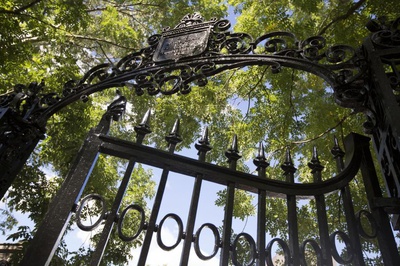
News
News Flash: Memory Shop and Anime Zakka to Open in Harvard Square

News
Harvard Researchers Develop AI-Driven Framework To Study Social Interactions, A Step Forward for Autism Research

News
Harvard Innovation Labs Announces 25 President’s Innovation Challenge Finalists

News
Graduate Student Council To Vote on Meeting Attendance Policy

News
Pop Hits and Politics: At Yardfest, Students Dance to Bedingfield and a Student Band Condemns Trump
Harvard Classes Don’t Have To Be This Boring
Falling asleep in lecture? You aren’t alone.
According to a report by the Classroom Social Compact Committee, Harvard students aren’t that interested in their courses. Harvard courses are boring, and active learning — a pedagogical method that prioritizes student engagement — is the solution.
Suggesting Harvard lectures are dull won’t sound novel to undergraduates (or anyone who has stepped foot in a large lecture hall). Look around and you’ll spot students texting their latest Datamatch situationships, victory-posting summer internships on LinkedIn, and — ironically — doing work for other classes. All the while, the lecturer monologues on without respite.
This problem isn’t limited to lectures. While large lectures logically lend themselves more easily to a depersonalized style of teaching, small sections and seminars can still suffer from the same stifled student engagement.
The committee’s report has sounded the alarm bells, and a litany of ideas focused on countering student disengagement have sprouted forth. Some intend to regulate student behavior, including implementing no-screen policies and requiring attendance and reading responses.
Others have proposed serious structural overhauls like un-reforming course registration, shrinking large lectures, and standardizing grading practices across courses — a herculean task.
While these proposals might mitigate the problem, they’re insufficient. Large policy changes are logistically infeasible and unlikely to be adopted. Likewise, regulating student behavior treats the symptoms of their disengagement but not the underlying etiology.
The fact is that many courses simply aren’t engaging, but the problem is not the screen policies, class sizes, or course subjects — it’s how they’re taught. If the University truly wants to improve course engagement, it should turn to the people whose job it is to teach — and think about what professors can do starting tomorrow.
Consider the status quo of a typical 100-person lecture in the Science Center. Few students want to lose focus. We don’t begin each lecture with the intention of online shopping, but sometimes it can be difficult to stay focused. When a professor ornately orates, voice droning rhythmically, it’s hard not to be lulled into a deep sleep — or at least a daydream. Truly, it would be a compliment to the professor — if it weren’t coming at the cost of our education.
It isn’t the fault of the professors, of course. It seems straightforward — they know the information, so they deliver it directly to the students. Their lips to our ears.
But it’s clear students don’t like long lectures any more than I assume professors like long faculty meetings.
The solution is active learning methods. Despite the name, active learning is more about how professors teach than how students learn. The strategies are neither fancy nor onerous to implement. They include simply asking students questions and providing time to work on problems without immediately giving them the answer.
These methods are flexible and can be adapted based on subject matter and course style. In math and physics classes (some of which already use active learning methods), professors can give students time to work through problems with each other. In social science lectures, students can converse with their classmates about the real-world implications of the course subjects and then share those thoughts with the entire class.
Harvard students often show up to class preoccupied, hungry, tired, or all of the above. Just asking them to share their thoughts with a neighbor could be enough to jolt them back to life.
Active learning methods don’t just sound good — research shows they work. A study from a few years ago found Harvard students who were taught using active learning methods scored almost half a standard deviation higher on an examination than their peers in traditional passive lectures — per the study’s methods, this constituted a statistically significant difference.
Harvard Professor of Physics and Applied Physics Eric Mazur even went as far as to say that the study “debunks the illusion of learning from lectures.”
Students don’t just learn more in active learning classrooms — they prefer them. According to the study’s author and Director of Science Teaching and Learning in the Faculty of Arts and Sciences, Louis Deslauriers, courses that implemented active learning techniques saw improved course evaluation ratings.
These results should not be shocking. I don’t imagine that finding long, monotonous lectures boring is unique to either Harvard or its students.
There is a critical caveat, however. Despite the fact that students learn more in active learning classrooms, they paradoxically feel as though they learn more in passive lectures.
If we ever hope to successfully implement these changes to courses, we must change how students view various learning methods.
The study suggests the way to solve this mismatch between perceived and actual learning is by telling students upfront in the beginning of the semester that active learning methods help them learn more — even if it doesn’t feel like it. If enough courses adopted such practices and active learning became the norm, the constant reminders would soon become unnecessary, and the misperception would be dispelled.
To make life easier, the Derek Bok Center for Teaching and Learning offers resources for active learning and other teaching methods for both professors and teaching fellows.
While it won’t be a panacea for all of Harvard’s woes, active learning could strike at the crux of student disengagement with minimal growing pains.
So, as the College reconciles with the findings of the Classroom Social Compact Committee, I’ll remind them that if they want active students, they need to embrace active learning.
Matthew R. Tobin ’27, a Crimson Editorial editor, is a double concentrator in Government and Economics in Winthrop House.
Want to keep up with breaking news? Subscribe to our email newsletter.
From Our Advertisers

Over 300+ courses at prestigious colleges and universities in the US and UK are at your disposal.

Where you should have gotten your protein since 1998.

Serve as a proctor for Harvard Summer School (HSS) students, either in the Secondary School Program (SSP), General Program (GP), or Pre-College Program.

With an increasingly competitive Law School admissions process, it's important to understand what makes an applicant stand out.

Welcome to your one-stop gifting destination for men and women—it's like your neighborhood holiday shop, but way cooler.

HUSL seeks to create and empower a community of students who are seeking pathways into the Sports Business Industry.

